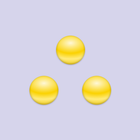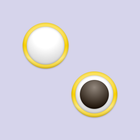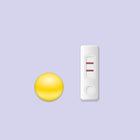Gold Nanoparticle Applications
Gold nanoparticles are one of the most commonly utilized nanomaterials due to their stability and optical properties.
Diagnostic Applications
Gold nanoparticles are readily conjugated to antibodies and other proteins due to the affinity of sulfhydryl (-SH) groups for the gold surface, and gold-biomolecule conjugates have been widely incorporated into diagnostic applications, where their bright red color is used in home and point-of-care tests such as lateral flow assays.
Biomedical Applications
Gold nanomaterials can be conjugated to biomolecules to specifically target cancer cells, and used for photothermal cancer therapy, where their tunable optical properties cause them to convert laser light into heat and selectively kill cancerous cells.
Plasmonics

Gold nanoparticles have unique optical properties because they support surface plasmons. At specific wavelengths of light the surface plasmons are driven into resonance and strongly absorb or scatter incident light. This effect is so strong that it allows for individual nanoparticles as small as 30 nm in diameter to be imaged using a conventional dark field microscope. This strong coupling of metal nanostructures with light is the basis for the field of plasmonics. Applications of plasmonic gold nanoparticles include biomedical labels, sensors, and detectors. The gold plasmon resonance is also the basis for enhanced spectroscopy techniques such as Surface Enhanced Raman Spectroscopy (SERS) and Surface Enhanced Fluorescence Spectroscopy which can be used to detect analytes with ultrahigh sensitivity.
Why Purchase From nanoComposix?
Extensive Characterization Data
Each batch of gold nanoparticles is extensively characterized using techniques including transmission electron microscopy (TEM), dynamic light scattering (DLS), zeta potential, and UV-Visible spectroscopy. In addition to ensuring that every batch of nanoparticles meets our stringent quality control requirements, customers are provided with batch-specific certificates of analysis containing representative TEM images, sizing data, hydrodynamic diameter and zeta potential measurements, UV-Visible spectrum, and solution pH.
Full Disclosure
Surface chemistry and suspension buffer details are provided for each material, and no proprietary coatings or mystery chemicals are used. Gold nanoparticle products are available with a range of capping agents including citrate, lipoic acid, polyethylene glycol (PEG), PEG carboxyl acid, polystyrene, dodecanethiol, polyvinylpyrrolidone (PVP), branched polyethylenimine (BPEI), silica, and amine-terminated silica.
Gold Nanoparticle Concentration

nanoComposix’s gold nanoparticles are provided at various low and high concentrations, 0.05 mg/mL (~1 OD), 1 mg/mL, 20 OD and 10 OD, depending on the product type. At higher concentrations, 1 mg/mL, 10 OD or 20 OD, the gold particles are a ruby red or orange/red color in solution depending on their size. The higher concentrated formulations are ideal for applications that require high concentrations and/or low residual reactants including nanotoxicology, environmental studies, and lateral flow assays. Even though the particles are made from a high-density material, smaller gold nanoparticles remain suspended in solution. Large gold nanoparticles may settle out of solution but are easily redispersed by simply shaking the storage vial.
Aggregation Free
Due to their small size, low mass, and extremely high surface area:volume ratios, once nanoparticles bind together it is often impossible to separate them. Consequently, most dried gold nanopowders that are resuspended consist of clusters of 100s of individual nanoparticles. For many plasmonics and biomedical applications, this agglomeration significantly degrades performance. At nanoComposix we have developed custom processing techniques that allow us to concentrate and purify nanoparticles without inducing agglomeration. The particles can be transferred into a variety of different solvents to enable their integration into a wide variety of systems. In addition, we have developed a surface stabilization technique that allows us to produce dried gold nanoparticles that can be redispersed into individual, monodisperse nanoparticles.

Customer Service
Our nanoparticle chemists will address your technical questions and help you select the optimal nanomaterial for your application.
Formulation Details
The following table links nanoparticle size with mass, atomic molarity, mass percent, particle concentration, and peak optical density for both 0.05 mg/mL and 1 mg/mL gold formulations.
0.05 mg/mL Gold Nanoparticles
| Size (nm) | Atomic (Au) Molarity (mmol/L) |
Particle Concentration (particles/mL) |
Au Mass Percent (%) |
Max Optical Density (cm-1) | Peak Wavelength (nm) |
|---|---|---|---|---|---|
| 5 | 0.254 | 3.95 × 1013 | 0.005 | 0.80 | 520 |
| 10 | 0.254 | 4.94 × 1012 | 0.005 | 0.82 | 520 |
| 20 | 0.254 | 6.18 × 1011 | 0.005 | 0.85 | 520 |
| 30 | 0.254 | 1.83 × 1011 | 0.005 | 1.1 | 520 |
| 40 | 0.254 | 7.72 × 1010 | 0.005 | 1.1 | 520 |
| 50 | 0.254 | 3.95 × 1010 | 0.005 | 1.5 | 525 |
| 60 | 0.254 | 2.29 × 1010 | 0.005 | 1.6 | 530 |
| 80 | 0.254 | 9.65 × 109 | 0.005 | 1.6 | 545 |
| 100 | 0.254 | 4.94 × 109 | 0.005 | 1.0 | 555 |
1 mg/mL Gold Nanoparticles
| Size (nm) | Atomic (Au) Molarity (mmol/L) |
Particle Concentration (particles/mL) |
Au Mass Percent (%) |
Max Optical Density (cm-1) | Peak Wavelength (nm) |
|---|---|---|---|---|---|
| 5 | 5.08 | 7.91 × 1014 | 0.1 | 16.0 | 520 |
| 10 | 5.08 | 9.88 × 1013 | 0.1 | 16.4 | 520 |
| 20 | 5.08 | 1.24 × 1013 | 0.1 | 16.9 | 520 |
| 30 | 5.08 | 3.66 × 1012 | 0.1 | 22.1 | 520 |
| 40 | 5.08 | 1.54 × 1012 | 0.1 | 22.6 | 520 |
| 50 | 5.08 | 7.90 × 1011 | 0.1 | 29.1 | 525 |
| 60 | 5.08 | 4.58 × 1011 | 0.1 | 31.8 | 530 |
| 80 | 5.08 | 1.93 × 1011 | 0.1 | 31.5 | 545 |
| 100 | 5.08 | 9.88 × 1010 | 0.1 | 20.1 | 555 |




